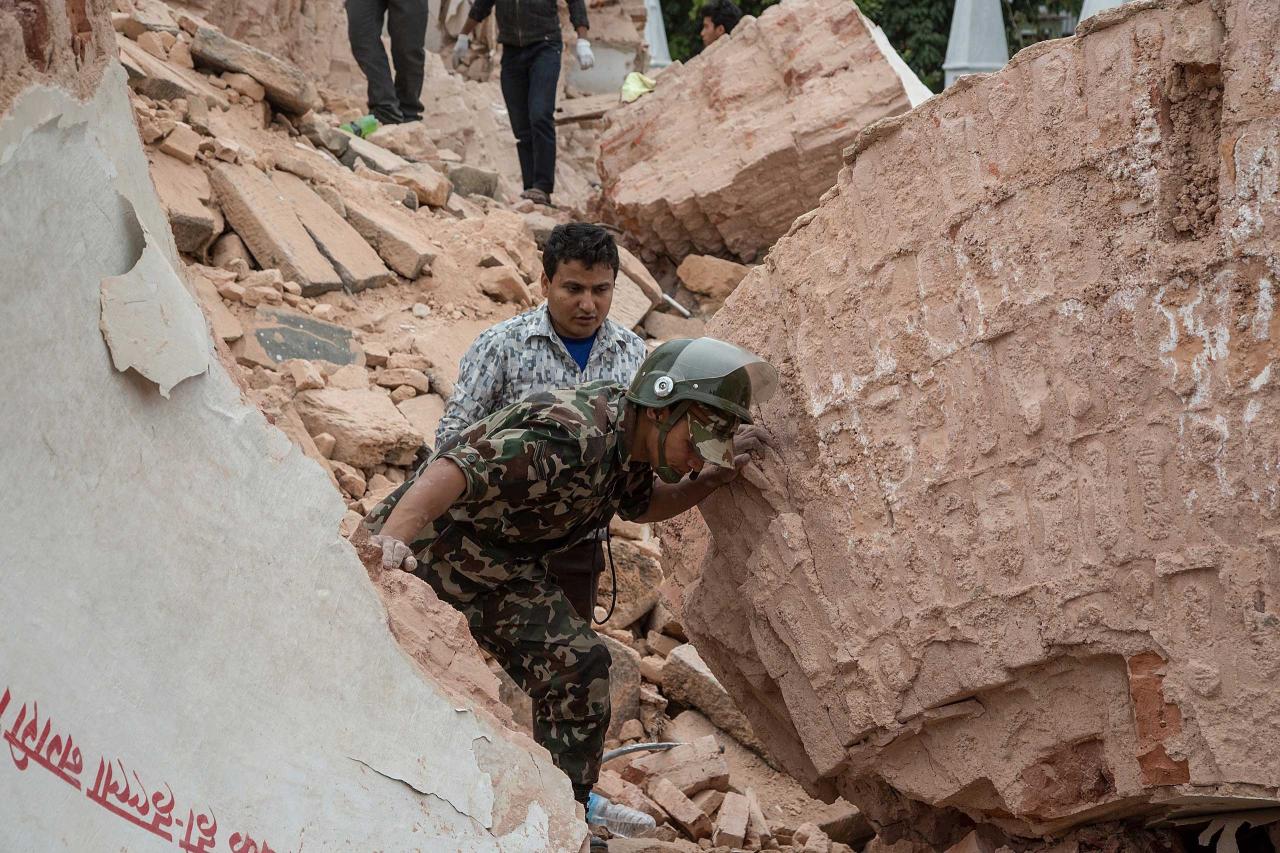The Nepal Earthquake
On April 25, 2015, a devastating earthquake struck Nepal, causing widespread destruction and claiming thousands of lives. The 7.8 magnitude earthquake, centered near the city of Gorkha, had a profound impact on the country’s infrastructure and population.
Impact on Infrastructure and Population
The earthquake triggered landslides, avalanches, and rockfalls, severely damaging roads, bridges, and buildings. The Kathmandu Valley, home to millions of people, was particularly affected, with many historical structures, including temples and monuments, collapsing. The earthquake also triggered an avalanche on Mount Everest, killing 19 people.
The immediate aftermath of the earthquake was marked by widespread chaos and panic. Communication networks were disrupted, hampering relief efforts. Thousands of people were left homeless, living in makeshift shelters with limited access to food, water, and medical care. The earthquake also caused widespread damage to hospitals and clinics, making it difficult to provide medical assistance to the injured.
Challenges Faced by Relief Efforts
The mountainous terrain and limited infrastructure in Nepal posed significant challenges for relief efforts. Access to remote areas was difficult, delaying the delivery of aid and rescue operations. The earthquake also triggered aftershocks, which continued for weeks after the main event, further complicating relief efforts.
Long-Term Consequences for Nepal’s Development
The earthquake had a profound impact on Nepal’s economy and development. The destruction of infrastructure, including roads, bridges, and power lines, disrupted transportation and communication networks, hindering economic activity. The earthquake also damaged agricultural land and livestock, impacting food security.
The long-term consequences of the earthquake for Nepal’s development are multifaceted. The country will need significant investments to rebuild infrastructure, provide housing for displaced people, and support economic recovery. The earthquake also highlighted the need for improved disaster preparedness and risk reduction measures to mitigate the impact of future disasters.
Facebook and Google’s Response
In the wake of the devastating Nepal earthquake in 2015, Facebook and Google quickly mobilized their resources and technology to provide assistance and support to the affected population. They launched various tools and initiatives aimed at facilitating communication, disseminating information, and mobilizing aid efforts.
Facebook’s Response
Facebook played a crucial role in connecting people and providing information during the Nepal earthquake. The platform introduced several features and initiatives to aid relief efforts.
- Safety Check: This feature allowed users to mark themselves safe after the earthquake, providing reassurance to loved ones and enabling friends and family to connect. Millions of people used Safety Check, helping to alleviate anxiety and provide a sense of security.
- Donation Button: Facebook partnered with the American Red Cross and other organizations to enable users to donate directly to relief efforts through the platform. This streamlined the donation process, making it easier for people to contribute financially.
- Information Hub: Facebook created a dedicated information hub for the Nepal earthquake, which aggregated news updates, resources, and contact information from various organizations involved in relief efforts. This served as a central source of information for people seeking updates and guidance.
Google’s Response
Google also responded swiftly to the Nepal earthquake, leveraging its technology and resources to provide support and assistance.
- Person Finder: Google launched its Person Finder tool, which allowed people to search for missing loved ones or register themselves as safe. This tool was widely used by those separated from family and friends during the disaster, facilitating reunification efforts.
- Google Maps: Google Maps played a vital role in providing real-time information about affected areas, including road closures, evacuation routes, and locations of relief centers. This helped responders navigate the affected regions and reach those in need.
- Google Crisis Response: Google’s Crisis Response team provided resources and support to local organizations involved in relief efforts, including data analysis, mapping, and communication tools. This collaborative approach enabled organizations to better coordinate their activities and reach those most affected.
Comparison of Approaches
Facebook and Google both utilized their platforms to facilitate communication, disseminate information, and mobilize resources during the Nepal earthquake. While their approaches shared similarities, they also differed in their specific tools and strategies.
- Focus: Facebook focused on connecting people and enabling donations, while Google emphasized providing information and supporting relief efforts with technology.
- Tools: Facebook’s Safety Check and donation button were designed to connect people and facilitate financial contributions, while Google’s Person Finder and Google Maps aimed at providing information and enabling efficient response efforts.
- Partnerships: Facebook partnered with organizations like the American Red Cross to streamline donations, while Google worked closely with local organizations to provide technical support and resources.
The Impact of Technology on Relief Efforts: Facebook Google Launch Tools For Nepals Earthquake Relief
The Nepal earthquake of 2015 highlighted the transformative power of technology in disaster response. Social media platforms and digital tools played a crucial role in coordinating relief efforts, bridging communication gaps, and mobilizing resources. While technology offered invaluable support, it also presented unique challenges that required careful consideration.
The Role of Social Media and Technology in Coordinating Relief Efforts
Social media platforms like Facebook and Twitter became vital communication channels during the aftermath of the earthquake. They enabled individuals to share information about their well-being, report on damage, and request assistance. These platforms also facilitated the dissemination of critical information from relief organizations, government agencies, and local communities.
- Information Sharing and Crowd-Sourcing: Social media platforms allowed for real-time updates on the situation, enabling individuals to share information about their location, needs, and the extent of damage. This crowd-sourced information provided valuable insights for relief organizations, helping them prioritize their efforts and allocate resources effectively.
- Connecting People and Resources: Social media platforms helped connect individuals in need with potential rescuers, aid providers, and volunteers. This facilitated the mobilization of resources and the coordination of relief efforts on a larger scale.
- Fundraising and Donation Management: Platforms like Facebook and GoFundMe enabled individuals to donate to relief efforts quickly and securely. This facilitated a rapid influx of financial support from across the globe, enabling relief organizations to respond swiftly and effectively to the crisis.
Overcoming Communication Barriers and Mobilizing Resources
Technology played a crucial role in overcoming communication barriers, particularly in remote areas affected by the earthquake. Mobile phone networks, despite some disruptions, remained operational, enabling communication between affected communities and the outside world.
- Satellite Phones and Communication Networks: Relief organizations utilized satellite phones and other communication technologies to establish contact with remote areas and coordinate rescue and relief operations. This ensured that critical information could be shared and coordinated efforts could be effectively implemented, even in areas with limited infrastructure.
- Mapping and Geographic Information Systems (GIS): Geographic information systems (GIS) proved instrumental in mapping the affected areas, identifying critical infrastructure, and planning logistical routes for relief supplies. This technology enabled relief organizations to efficiently allocate resources and prioritize areas with the most urgent needs.
- Mobile Applications and Digital Platforms: Mobile applications and digital platforms were developed and utilized to track missing persons, provide information on relief efforts, and connect individuals with resources. These platforms provided a centralized hub for information sharing and facilitated a more coordinated response to the crisis.
Limitations and Challenges of Technology in Disaster Response
While technology offers significant benefits in disaster response, it also presents unique challenges.
- Information Overload and Accuracy: The rapid dissemination of information through social media can lead to information overload and the spread of misinformation. It is crucial to verify information from credible sources and avoid relying solely on social media for accurate updates.
- Digital Divide and Access: Not everyone has access to technology, particularly in remote areas or among vulnerable populations. This digital divide can exacerbate existing inequalities and hinder the effectiveness of technology-driven relief efforts.
- Privacy Concerns and Data Security: The collection and use of personal data in disaster response can raise privacy concerns. It is essential to ensure that data is collected and used ethically and responsibly, with appropriate safeguards in place to protect individuals’ privacy.
Lessons Learned and Future Implications
The Nepal earthquake of 2015 presented a unique challenge for humanitarian aid organizations, highlighting both the potential and limitations of technology in disaster relief. Facebook and Google, with their vast resources and global reach, played a significant role in the response efforts. This section examines the key lessons learned from their initiatives, outlining the impact, challenges encountered, and recommendations for future improvements.
Lessons Learned from Facebook and Google’s Response
The following table summarizes the key lessons learned from Facebook and Google’s response to the Nepal earthquake:
| Tool/Initiative | Impact | Challenges | Future Recommendations |
|---|---|---|---|
| Facebook Safety Check | Enabled users to mark themselves safe, connecting families and friends. Provided valuable data on the extent of the disaster. | Limited reach in rural areas due to internet connectivity issues. Concerns about privacy and data security. | Improve accessibility in remote areas. Implement robust privacy and security measures. |
| Google Person Finder | Facilitated reconnections by allowing users to search for missing persons and post information about their whereabouts. | Dependence on user participation. Limited effectiveness in areas without internet access. | Promote awareness and encourage widespread use. Develop offline access options. |
| Google Maps and Earth | Provided real-time updates on the affected areas, aiding relief efforts in navigating damaged infrastructure and reaching affected communities. | Data accuracy and availability varied depending on the region. | Invest in data collection and maintenance for improved accuracy and real-time updates. |
| Facebook Fundraisers | Facilitated donations from individuals and organizations to support relief efforts. | Limited transparency in fund distribution. | Enhance transparency in fund management and distribution. |
Implications for Future Disaster Relief Efforts, Facebook google launch tools for nepals earthquake relief
The experience in Nepal underscored the crucial role of technology in disaster relief. It demonstrated the potential for social media platforms and search engines to facilitate communication, aid in search and rescue efforts, and mobilize resources.
- Improved Connectivity: The lack of internet access in many affected areas hindered the effectiveness of technology-based solutions. Future efforts should prioritize expanding internet infrastructure, particularly in remote and vulnerable communities, to ensure wider reach and accessibility.
- Data Privacy and Security: The use of personal data in disaster relief efforts raises concerns about privacy and security. Robust data protection measures are essential to ensure responsible and ethical use of information.
- Collaboration and Coordination: Effective disaster response requires collaboration between technology companies, government agencies, and humanitarian organizations. Establishing clear communication channels and standardized protocols can enhance coordination and efficiency.
- Training and Capacity Building: Investing in training programs for local communities on using technology for disaster preparedness and response is crucial. This includes educating people on how to use digital tools for communication, information sharing, and accessing resources.
Facebook google launch tools for nepals earthquake relief – The Nepal earthquake served as a stark reminder of the devastating impact natural disasters can have, but it also highlighted the incredible potential of technology in providing support and facilitating recovery. Facebook and Google’s response demonstrated the transformative power of digital tools in times of crisis, showcasing how they can be used to connect people, share information, and mobilize resources for a common cause. This experience paved the way for future innovations in disaster relief, emphasizing the crucial role technology plays in building resilience and ensuring a faster, more effective response to future emergencies.
Facebook and Google stepped up to help Nepal after the devastating earthquake, launching tools to connect families and provide aid. But while tech giants were mobilizing for good, one oil executive was busy trying to pull a fast one – he was sued by Tesla for impersonating Elon Musk ! Thankfully, the tech giants’ efforts were focused on helping Nepal recover, not on outlandish impersonations.
 Standi Techno News
Standi Techno News

